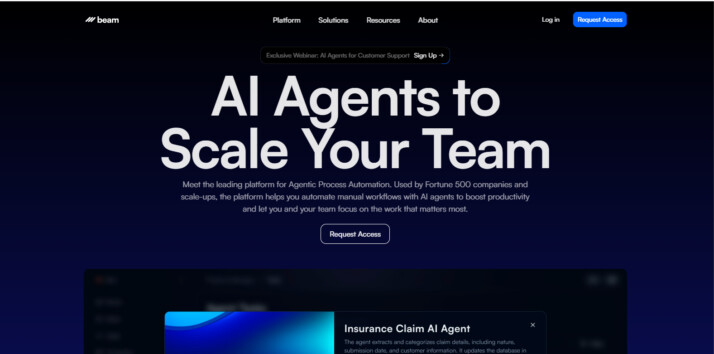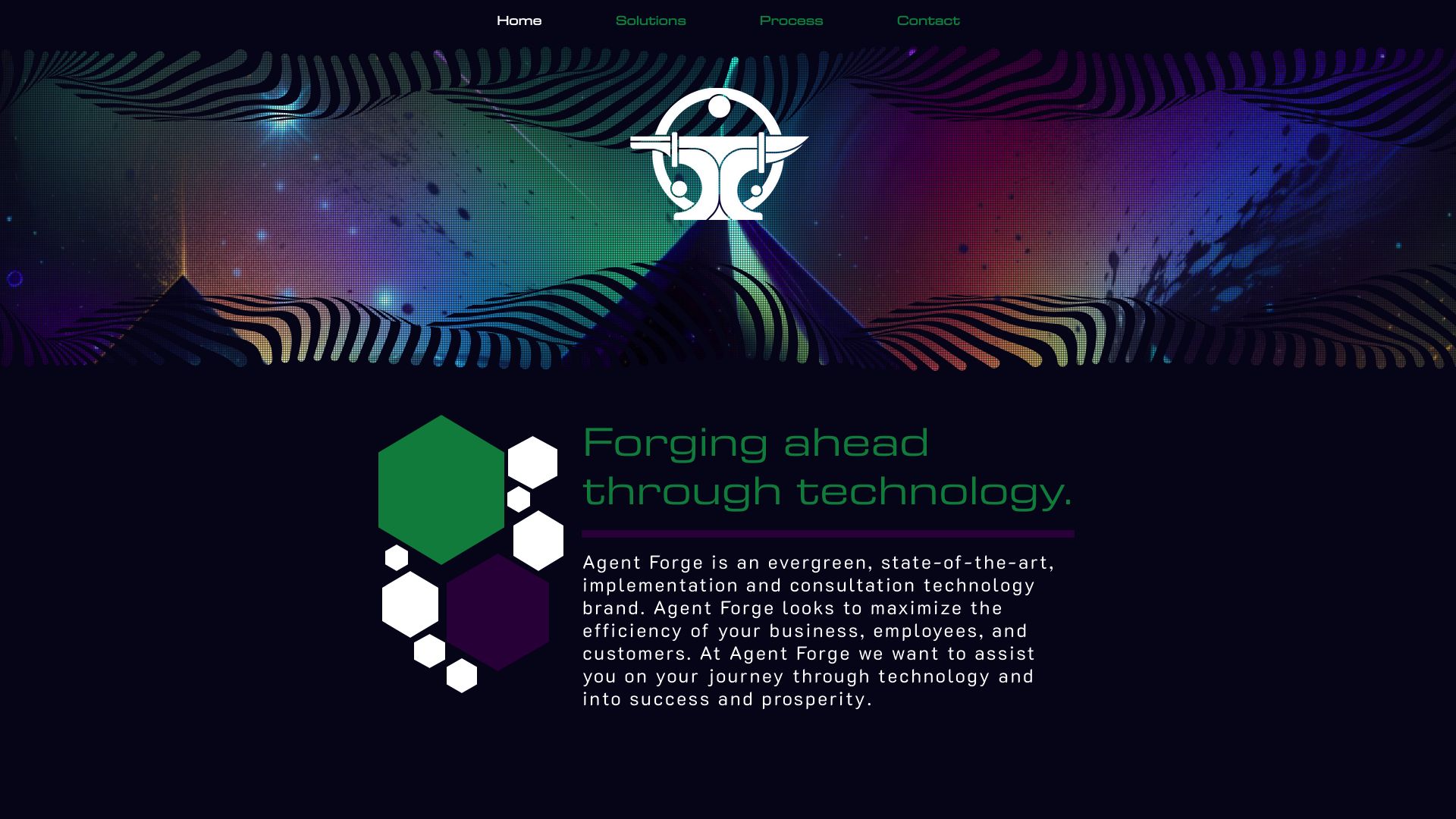Beam AI vs. Agent Forge: Comparing Enterprise and Open-Source AI Platforms
AI agent development platforms empower organizations to automate complex tasks, streamline workflows, and boost productivity. This comparison examines Beam AI’s enterprise-focused Agentic Process Automations, Agent Forge’s flexible open-source framework, and SmythOS’s comprehensive AI agent development ecosystem. We evaluate each platform’s capabilities, ease of use, and suitability for various user groups — from developers seeking customization to business users requiring no-code solutions. By exploring key features, deployment options, and integration capabilities, this guide equips readers to select the AI agent platform best suited to their technical expertise and business needs.
Beam AI Overview
Beam AI specializes in developing intelligent, autonomous agents designed to revolutionize task automation and workflow optimization. These Agentic Process Automations (APAs) excel at handling repetitive tasks across various domains, including data management, customer service, compliance, and order processing. By leveraging advanced AI capabilities, Beam’s agents continuously learn and adapt, becoming increasingly efficient over time.
Beam AI focuses on creating sustainable, AI-native solutions that minimize human carbon footprint while maximizing productivity. Their platform emphasizes speed, efficiency, and customer-centric innovation, aiming to build a future driven by artificial general intelligence (AGI). Beam’s international team collaborates to push the boundaries of AI technology, ensuring their solutions remain at the forefront of automation and intelligent task management.
Beam AI specializes in developing intelligent, autonomous agents designed to revolutionize task automation and workflow optimization.


The platform offers robust features for seamless integration with existing systems, enabling organizations to streamline complex workflows. Beam AI’s agents boast advanced conversational interfaces, facilitating natural interactions between humans and AI. This capability enhances task execution efficiency and improves overall user experience. The system supports multi-agent collaboration, allowing multiple AI entities to work together on intricate projects.
Beam AI’s agents boast advanced conversational interfaces, facilitating natural interactions between humans and AI.
While Beam AI provides powerful automation tools, it lacks a visual builder or no-code editor, which may present a challenge for non-technical users seeking to create custom workflows. Additionally, the platform does not offer multimodal capabilities or a dedicated debug mode, potentially limiting its applicability in certain scenarios. Despite these limitations, Beam AI’s focus on explainability, transparency, and ethical AI usage positions it as a strong contender in the enterprise AI market.
Beam AI’s commitment to scalability, security, and compliance makes it particularly attractive to large organizations dealing with sensitive data and complex regulatory environments. The platform’s support for various deployment options, including APIs, webhooks, and scheduled agents, provides flexibility in implementation. However, potential users should consider their specific technical requirements and in-house expertise when evaluating Beam AI as a solution for their automation needs.
Agent Forge Overview
Agent Forge empowers developers to build intelligent, autonomous AI agents using Python. This open-source framework provides a flexible foundation for creating customizable agents that can automate tasks, enhance workflows, and solve complex problems.
Agent Forge supports major language models like Claude and GPT, along with self-hosted options via Oobabooga. Its modular architecture allows developers to rapidly prototype and iterate on agent designs. Key features include flexible memory management with ChromaDB, pre-built agent templates, and easy integration of custom data sources and APIs.
Agent Forge empowers developers to build intelligent, autonomous AI agents using Python. This open-source framework provides a flexible foundation for creating customizable agents that can automate tasks, enhance workflows, and solve complex problems.


The platform excels at orchestrating multi-agent systems and complex workflows. Its prompt engineering capabilities guide agent behavior, while shared utility classes simplify common tasks. This makes Agent Forge well-suited for prototyping AI assistants, chatbots, and expert systems across various domains.
While powerful, Agent Forge requires Python knowledge to fully leverage its capabilities. The lack of a visual builder or no-code option may limit accessibility for non-technical users. Additionally, as an open-source project, enterprise support options may be more limited compared to commercial alternatives.
Agent Forge positions itself as an accessible playground for AI experimentation. Its modular, extensible nature makes it ideal for long-term projects where customization and flexibility are key. For developers and organizations looking to push the boundaries of autonomous agent technology, Agent Forge provides a solid foundation to build upon.
Feature Comparison
Beam AI and Agent Forge offer distinct approaches to AI agent development, each with its own strengths and limitations. Beam AI excels in creating autonomous agents for enterprise-level automation, while Agent Forge provides a flexible open-source framework for developers.
Beam AI’s hosted agents support both development and production environments, enabling seamless deployment across organizational needs. However, it lacks a visual builder or no-code editor, potentially limiting accessibility for non-technical users. In contrast, Agent Forge empowers developers with a Python-based framework but requires coding expertise to fully utilize its capabilities.
When it comes to security, Beam AI demonstrates robust features including data encryption, OAuth support, and IP control. Agent Forge, being open-source, relies more heavily on developer-implemented security measures. This difference highlights SmythOS’s advantage in offering comprehensive, built-in security features that cater to enterprise requirements while maintaining flexibility for customization.
Feature Comparison Table
| Beam AI | Agent Forge | SmythOS | |
|---|---|---|---|
| CORE FEATURES | |||
| Visual Builder | ❌ | ❌ | ✅ |
| No-Code Options | ❌ | ❌ | ✅ |
| Explainability & Transparency | ✅ | ❌ | ✅ |
| Debug Tools | ❌ | ❌ | ✅ |
| Multimodal | ❌ | ❌ | ✅ |
| Audit Logs for Analytics | ✅ | ❌ | ✅ |
| Work as Team | ✅ | ❌ | ✅ |
| Bulk Work | ✅ | ❌ | ✅ |
| Agent Work Scheduler | ✅ | ❌ | ✅ |
| Logs & Monitoring | ✅ | ❌ | ✅ |
| SECURITY | |||
| Constrained Alignment | ✅ | ❌ | ✅ |
| Data Encryption | ✅ | ❌ | ✅ |
| OAuth | ✅ | ❌ | ✅ |
| IP Control | ✅ | ❌ | ✅ |
| COMPONENTS | |||
| Foundation AIs | ✅ | ❌ | ✅ |
| Huggingface AIs | ✅ | ❌ | ✅ |
| Zapier APIs | ✅ | ❌ | ✅ |
| All other APIs, RPA | ✅ | ❌ | ✅ |
| Classifiers | ✅ | ❌ | ✅ |
| Logic | ✅ | ❌ | ✅ |
| Data Lakes | ❌ | ❌ | ✅ |
| DEPLOYMENT OPTIONS (EMBODIMENTS) | |||
| Deploy as API | ✅ | ❌ | ✅ |
| Deploy as Webhook | ✅ | ❌ | ✅ |
| Staging Domains | ✅ | ❌ | ✅ |
| Production Domains | ✅ | ❌ | ✅ |
| API Authentication (OAuth + Key) | ✅ | ❌ | ✅ |
| Deploy as Site Chat | ✅ | ❌ | ✅ |
| Deploy as Scheduled Agent | ✅ | ❌ | ✅ |
| Deploy as GPT | ✅ | ❌ | ✅ |
| Scalability | ✅ | ❌ | ✅ |
| DATA LAKE SUPPORT | |||
| Hosted Vector Database | ❌ | ❌ | ✅ |
| Sitemap Crawler | ❌ | ❌ | ✅ |
| YouTube Transcript Crawler | ❌ | ❌ | ✅ |
| URL Crawler | ❌ | ❌ | ✅ |
| Word File Support | ✅ | ❌ | ✅ |
Best Alternative to Beam AI and Agent Forge
SmythOS stands out as the superior alternative to Beam AI and Agent Forge, offering a comprehensive AI agent development platform that combines power with accessibility. Our drag-and-drop interface enables users to create sophisticated AI workflows without extensive coding knowledge, democratizing AI development across skill levels.
Unlike Beam AI’s enterprise-focused approach or Agent Forge’s developer-centric framework, SmythOS provides a versatile solution that caters to both technical and non-technical users. We offer pre-built API integrations and templates, significantly reducing setup time and allowing users to focus on innovation rather than implementation details.
SmythOS provides a versatile solution that caters to both technical and non-technical users … significantly reducing setup time and allowing users to focus on innovation rather than implementation details.
SmythOS excels in its expansive feature set, addressing limitations found in both Beam AI and Agent Forge. Our platform supports multimodal interactions, enabling AI agents to process and respond to various data types including text, images, and voice. This versatility opens up a wider range of use cases and applications compared to our competitors.
Security and scalability are paramount in SmythOS. We provide robust data encryption, OAuth support, and IP control features out-of-the-box, ensuring enterprise-grade security without sacrificing ease of use. Our platform scales effortlessly to meet growing demands, supporting everything from small-scale prototypes to large-scale production deployments.
With SmythOS, users gain access to an unparalleled ecosystem of AI models and integrations. We support a vast array of foundation models, Hugging Face integrations, and seamless connections to popular services via Zapier. This extensive compatibility ensures that our platform can adapt to virtually any workflow or business process, providing unmatched flexibility in AI agent development and deployment.
Conclusion
Beam AI, Agent Forge, and SmythOS each bring unique strengths to the AI agent development landscape. Beam AI excels in enterprise-level automation with its Agentic Process Automations, while Agent Forge offers developers a flexible open-source framework for customization. However, SmythOS emerges as the superior choice, combining the best of both worlds with its user-friendly interface and powerful capabilities.
SmythOS stands out with its intuitive drag-and-drop builder, enabling users of all technical levels to create sophisticated AI agents. This accessibility, coupled with support for over 300,000 integrations, allows for unprecedented flexibility in automating complex workflows. Unlike Beam AI’s lack of a visual builder or Agent Forge’s reliance on coding expertise, SmythOS democratizes AI development without sacrificing advanced features.
Furthermore, SmythOS’s comprehensive security measures, including data encryption and OAuth support, address the enterprise-level concerns that Beam AI targets, while maintaining the extensibility that Agent Forge users appreciate. The platform’s ability to deploy agents across various environments — from APIs to chatbots to scheduled tasks — showcases its versatility in meeting diverse business needs.
For those ready to experience the future of AI agent development, we invite you to explore our diverse range of AI-powered agent templates. These templates offer a running start in creating tailored solutions for your specific needs. To begin building your own AI workforce and revolutionize your workflow, create a free SmythOS account today. With our risk-free trial and the power to create unlimited AI agents at no initial cost, there’s never been a better time to harness the potential of AI for your business.
Last updated:
Disclaimer: The information presented in this article is for general informational purposes only and is provided as is. While we strive to keep the content up-to-date and accurate, we make no representations or warranties of any kind, express or implied, about the completeness, accuracy, reliability, suitability, or availability of the information contained in this article.
Any reliance you place on such information is strictly at your own risk. We reserve the right to make additions, deletions, or modifications to the contents of this article at any time without prior notice.
In no event will we be liable for any loss or damage including without limitation, indirect or consequential loss or damage, or any loss or damage whatsoever arising from loss of data, profits, or any other loss not specified herein arising out of, or in connection with, the use of this article.
Despite our best efforts, this article may contain oversights, errors, or omissions. If you notice any inaccuracies or have concerns about the content, please report them through our content feedback form. Your input helps us maintain the quality and reliability of our information.
